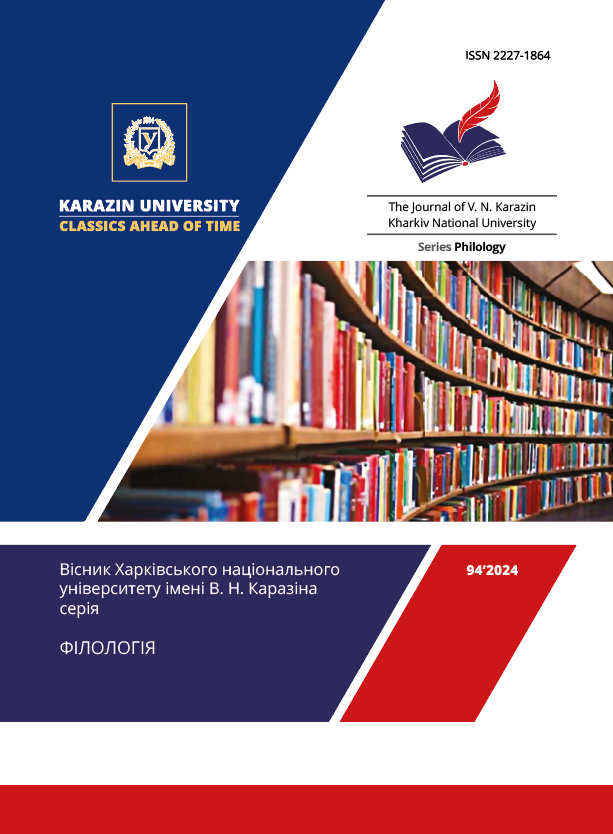Linguocultorological reasons for the different levels of somatization of sadness in languages of the world
Abstract
Considering their important role in human life the study of emotions is of great interest for linguistic science. This article is dedicated to the analysis of the phenomenon of somatization of sadness and the explanation of differences in the levels of such somatization as reflected in language.
The analysis of literature has shown that expression of sadness with the help of somatic expressions is particularly prevalent in African, South-East Asian and Australian languages. Organs that are most often associated with emotions are the heart, liver and stomach and interoception plays a great role in creating an association between an organ and an emotion. With its help a person becomes aware of the physical changes taking place inside their body, which can be caused in particular by emotions. It was established that certain associations between organs and emotions come to exist due to “somatic bridges” while others form because of “semantic shift”. It was found that the frequency of the use of somatic expressions that express emotions was reduced in English during the industrialization and that similar changes are taking place today in Chinese.
In order to explain the differences in the level of somatization it is useful to turn to the triadic structure of concepts, in accordance to which the concept “sadness” has an experiential side (an interoceptive characterization of the emotion), a notional side (a definition, verbal representation etc.) and an evaluative side. It is hypothesized that an important role of somatic expression in the expression of sadness points to the importance of the experiential side while the use of abstract words is indicative of the notional side being important. The fact that the experiential side of a concept is considered to predate the notional side explains the direction of the diachronic change from stronger somatization of emotions towards their expression with the help of more abstract notions.
Downloads
References
Arias, J. A., Williams, C., Raghvani, R., Aghajani, M., Baez, S., Belzung, C., Booij, L., Busatto, G., Chiarella, J., Hy Fu, C., Ibanez, A., Liddell, B. J., Lowe, L., Penninx, B., Rosa, P., Kemp, A. H. (2020) The neuroscience of sadness: A multidisciplinary synthesis and collaborative review. Neuroscience and Biobehavioral Reviews, 111, 199–228.
Dzherikh, O. (2018) “Concept” in modern cognitive linguistics and lingvocultural studies: definition and structure. Typologia movnyh znachen u diahronichnomu ta zistavnomu aspektah, 35–36, 62–69.
Dzokoto, V. & Chentsove-Dutton Y. (2014) Listen to Your Heart: The Cultural Shaping of Interoceptive Awareness and Accuracy. Emotion, 14 (4), 666–678. https://doi.org/10.1037/a0036193
Dzokoto, V.A. & Okazaki, S. (2001) Happiness in the Eye and the Heart: Somatic Referencing in West African Emotion Lexica. Journal of black psychology, 32(2), 117–140. https://doi.org/10.1177/0095798406286799
Farooq, S., Gahir, M. S., Okyere, E., Sheikh, A. J., & Oyebode, F. (1995) Somatization: a transcultural study. Journal of psychosomatic research, 39(7), 883–888. https://doi.org/10.1016/0022-3999(94)00034-6
Jaisser, A. (1990) DeLIVERing an Introduction to psycho-collocations with SIAB in White Hmong. Linguistics of the Tibeto-Burman area, 13 (1), 159–178.
Kovecses, Z. (2020) Emotion concepts in a new light. Rivista Italiana di Filosofia del Linguaggio, P. 42-54.
Litiaha, V. (2013) Term “concept” in the modern linguistic paradigm Naukovyi visnyk Kyivskogo nacionalnogo universytetu imeni Tarasa Shevchenko. Inozemna filolohiia, 46, 48–50.
Matisoff, J. (1986) Hearts and minds in South-East Asian languages and English: an essay in the comparative lexical semantics of psycho-collocation. Cahiers de Linguistique – Asia Orientale, 15 (1), 5–52. https://doi.org/10.1163/19606028-90000013
McPherson, L., & Prokhorov, K. (2011) The use of “liver” in Dogon emotional encoding. In G.C. Batic (Ed.), Emotional encoding in African languages. LINCOM studies in African languages 84 (pp. 38–55).
Ogarkova, A. (2013) Folk emotion concepts: Lexicalization of emotional experiences across languages and cultures. In J. Fontaine, K. Scherer, C. Soriano (Eds.), Components of Emotional meaning: A sourcebook. Oxford academic. https://doi.org/10.1093/acprof:oso/9780199592746.003.0004
Ovsienko, V. (2010) Linguistic and cultural concept in linguistics. Movoznavhyi visnyk. Zbirnyk naykovyh praz, 11, 243–246.
Panin, Е. (2019) Lexical and phraseological types of concepts in English. Naukovyi visnyk Uzhorodskogo universytetu. Seriia «Filolohiia», 41, 87–90.
Ponsonnet, M. (2020) The role of the body in descriptions of emotions: A typology of the Australian continent. Pragmatics and cognition, 27 (1), 20–82. https://doi.org/10.1075/pc.00011.pon
Stears, P.N. (1994) Constructing a Twentieth-Century Emotional Style. NYU press.
Selivanova, O. (2010) The linguistic encyclopedia. Dovkilla-K.
Venzhynovych, N. (2016). The concept and its linguocultural nature. Naukovyi visnyk Uzhorodskogo universytetu. Seriia «Filolohiia», 14, 89–94.
Zhou, P., Critchley, H., Garfinkel S., Gao, Y. (2021) The conceptualization of emotions across cultures: a model based on interoceptive neuroscience. Neuroscience and biobehavioral reviews, 125, 314–327. https://doi.org/10.1016/j.neubiorev.2021.02.023




